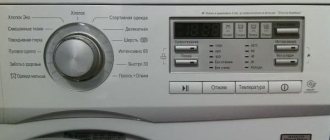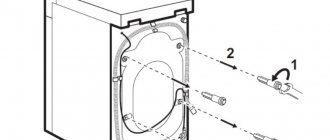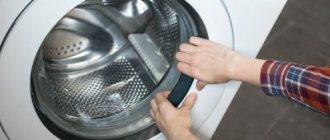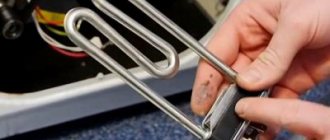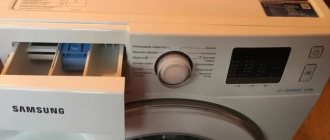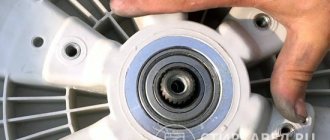The design features of the tray in the Indesit brand automatic machine cause difficulties when trying to remove it from the installation socket, which sometimes leads to breakage of the cuvette.
Even after carefully reading the instructions and repeated attempts to follow the recommendations outlined in it, all actions end in failure.
How to remove the powder tray from the Indesit washing machine without damaging the device? Below is a detailed description of simple manipulations with which the tray can be removed without difficulty.
A note for Indesit washing machine owners
Sometimes the use of simple tips prevents the negative effects of substances that are aggressive towards household appliances, and following some of them returns household items to their original properties:
- A little trick to make it easy to get the tray out: to make it easier to remove the tray from the Indesit machine, grind off the limiting protrusions by literally 1 mm with sandpaper or a file. In the future, the tray will be pulled out without problems.
- Don’t be lazy to regularly remove and clean the tray from the Indesit automatic machine. After all, the accumulation of plaque, mold and bacteria during the washing process enters the drum with water and remains on the items being processed!
- After using bleach, you should turn on the dry wash cycle. This will help prevent the aggressive effect of the bleach remaining on the walls of the container and the entire washing system on colored items during subsequent loads.
Detailed operating instructions for Indesit washing machines are presented in this section.
Preventive measures
The service life of household appliances directly depends on their care. Therefore, for preventive purposes, it is recommended to follow simple but important rules:
- Systematically clean the internal and external surfaces of the detergent dispenser - after 1 - 2 washes.
- Remove dirt not only from the tray, but also from its nest.
- Once a month, wash the entire system of tubes through which detergents enter the drum with citric acid powder, using the method described above.
Ignoring preventive measures is the reason for the appearance of plaque on the tray and, as a result, poor quality washing.
Why might you need to remove the box?
A clogged powder loading tray can cause the machine to not function properly.
There are several reasons for cuvette contamination:
- If the water pressure is low, the detergents are not fully used. Over time, they accumulate on the walls of the housing in the form of a sticky coating, which reduces their supply to the drum. This negatively affects the quality of the wash.
- Plaque on the walls of the cuvette also appears when using a rinse aid. The active components of the product are located in a special compartment of the tray from the beginning to the final stage of washing, as a result of which they stick to the walls of the container.
- The quality and type of media used also affects the condition of the unit for loading them. When using powder, plaque forms faster than when using liquid preparations.
Without systematic cleaning of the cuvette, in addition to detergent residues, contaminants from the clothes and linen being treated accumulate on its surface.
This provokes the formation of mold and fungi, for which the presence of humidity and a comfortable temperature becomes a favorable environment for reproduction.
Preparing for launch
All modern models of washing machines differ little from each other in terms of launch. Before turning on the washing machine, check whether there is a power cord and whether the device is grounded. If everything is normal, then you can load laundry into the drum.
Each washing machine drum has its own weight category for which it is designed. Be careful, overloading may cause the crosspiece to fail. Most modern models have a function that notifies you if you have put more clothes than necessary.
After loading things, close the door. If you have a vertical drum, first close the door, and then the hatch. In a horizontal drum, close only the door.
The powder packaging must indicate the dose that needs to be poured into the compartment.
It is important to stick to the dose, because if you pour in the powder, foam will appear, and if you do not add enough of it, the clothes may not be washed at all. To make sure you don't make a mistake, use a special measuring cup.
The powder tray has three sections:
- left – main department,
- medium – intended for air conditioning,
- right – preliminary.
Powder tray Basically, the compartments are located like this: on the left - for the main wash, next to it - for rinsing and pre-washing.
Now we need to supply the car with water. Most washing appliances are connected directly to the water supply, but some models have separate tanks. After completing this action, we connect the device to the network.
Next, you select the washing mode. The operating mode is selected by pressing the corresponding buttons. It is worth considering that they are determined taking into account the type of washing and the fabric that they plan to wash.
Selecting a washing mode
At this stage of time, there are the following types of washing:
- gentle wash,
- children's clothing,
- quick wash,
- washing everyday clothes.
As for fabrics, there are separate modes for the following types of fabrics:
Types of modes:
- Special mode: This function is mainly found in new models; it disinfects and protects white items with steam and helps remove stains. It should be described in more detail in your machine manual.
- Delicate wash: slow wash and low rinse speed. It’s good in that it prevents things from looking worn out, but it doesn’t wash very thoroughly. Suitable for delicate items.
- Light spin: First a quick wash, then a slow wash.
- Normal: quick rinse and equally quick spin.
Temperature detection
Temperature ranges from 30 to 95 degrees. Here are some recommendations for choosing a mode:
- The temperature is selected depending on how dirty the clothes are. If you just need to refresh, then choose 30-40 degrees.
- Synthetics wash perfectly in conditions of 40-60 degrees.
- Bed and bath linen and accessories require the highest temperature.
Spin intensity
The intensity is determined by the number of revolutions per minute. Naturally, the more efficient the spin cycle, the less water there is in the clothes; you get almost dry clothes out of the washing machine.
Don’t forget that fabrics that require more care should be washed at a lower intensity. It is generally better to wash silk and chiffon without the spin function.
Washing program
Next we need to set the washing program. The differences between models are quite high with this function. Be sure to take into account the temperature conditions; if you do not turn it on carefully, you can damage things.
All information should be described in detail in your instructions. Expensive models are equipped with touch sensors, while simpler ones have a regular wheel. Now let’s start, to do this we find the “Start” button and press it.
When the washing process comes to an end, depending on your device, it will give a signal or a sound, or the button will flash that the wash has come to an end. We disconnect the device from the power supply, open the door and take out things.
Simplify tray removal process
After you have managed to remove the powder container from the washing machine for the first time and remove dirt from it, there is no need to rush to put the container back in place. This is explained by the fact that the secondary procedure for removing the container from the machine may also be accompanied by problems due to the same teeth.
That is why professional craftsmen recommend stocking up on sandpaper or a needle file and slightly sharpening the interfering teeth. There is no need to apply a lot of force; it will be enough to cut off approximately 1 mm.
Thanks to these actions, the container will be easier to remove and it will not jump out on its own if you pull it a little harder.
Sequence of actions and features
Removing the lid from front-loading models differs from those with vertical loading. In each option the procedure will be different.
How to open a top-loading washing machine?
If it is necessary to remove the top cover from a top-loading Indesit washing machine, you will also need to remove the dashboard.
The disassembly process has its own characteristics:
- pull out the washing machine so that it is accessible from all sides;
- Unscrew the fixing screws from the rear wall - they are located behind the dashboard;
- the control unit is retracted up and forward - this must be done carefully, since the supply wires pass under the plastic;
- after disconnecting the control panel, access to the retaining screws opens; they need to be unscrewed;
- remove the cover.
The supply wires require work to be carried out very carefully. For ease of disassembling the machine, it is advisable to disconnect them from the control unit, and the removed panel can be completely put aside.
The process of removing the lid from a top-loading washing machine can be seen in the video:
From the front
When removing the lid from a horizontal-loading model, be aware of the tight plastic latches
It is very important not to damage them, as it will be impossible to fix the damage.
Work algorithm:
- The washing machine must be pulled out so that it is possible to enter from the rear.
- On the rear panel side, there are two screws at the top. They need to be found and unscrewed.
- It must be located on the back wall of the washing machine.
- Lift the back side of the cover with your hands and pull it towards you until it clicks. This is the latching signal.
- If the previous method did not work to move the panel, you need to walk around the washing machine and stand on the front side facing the machine.
- You need to rest your hands on the top of the plastic and push it away from you.
The use of a screwdriver may only be recommended for removing screws and not as a lever to remove the cover.
The detailed process of removing the cover is shown in the video:
Top 5 useful tips
To ensure that your washing machine lasts as long as possible and the cuvette does not become clogged, you can use simple tips:
- To avoid the formation of mold, use detergents containing antibacterial components.
- Give preference to quality detergents. They dissolve faster and do not leave residue on the walls of the tray and other elements of the device.
- Use a special filter to purify water. This will prevent the formation of limescale deposits.
- To avoid damaging the plastic surface of the tray or erasing the marks on it, avoid using aggressive chemicals.
- Don't forget to machine the tray mounting socket. This is a favorite place for dirt, limescale and mold to accumulate.
With careful care of all elements of the LG washing machine, it will delight you not only with its appearance, but also with the effectiveness of the procedures performed. Keeping the unit clean is a guarantee of a long shelf life of the device.
Cleaning individual elements of the washing machine
How to clean a washing machine drum
Owners of household appliances who do not know how to clean an automatic washing machine with citric acid need only study the simple instructions.
To remove scale from the drum, you need to select the “hot” wash mode, pour the product into the powder compartment and start working with an empty tank. Cleaning the drum with citric acid
“Idle” washing must be carried out using the “Spin” and “Rinse” modes. As for the temperature, it is enough to set it to 60°C. After finishing the machine, wipe the surface of the drum thoroughly dry.
Please note that during operation of the unit, sounds resembling crackling may occur. This indicates the destruction of deposits
During rinsing they will be removed into the drain system.
How to clean an elastic band in a washing machine
Rubber is easily cleaned of scale and salts after washing with citric acid. If dirt and impurities remain, they can be removed using ordinary detergents. To properly clean rubber, after using household chemicals, you must thoroughly wash its surface using running water and a clean cloth.
Cleaning the sealing rubber of an automatic machine
It is imperative to remove the rubber rim and check it for the absence of foreign objects and fungus. It is not recommended to use various lubricants that prevent cracks.
How to clean the filter in a washing machine
The filtration system of washing machines also needs periodic cleaning. This must be done because small objects and dirt accumulate, which leads to the flow of water with weak pressure.
In addition, the duration of the wash increases, and the machine begins to hum when pouring water. All these signs indicate the need for preventive measures. How to clean the filter in a washing machine from Indesit and other brands?
Removing the washing machine filter
First you need to unscrew and disconnect the water filling hose from the washing machine. After this, remove the filter mesh. For these purposes it is better to use pliers.
To clean the device from dirt, it is advisable to use an old toothbrush. After this, the mesh is washed in running water. If owners of household appliances do not know, for example, how to clean the filter in a Samsung washing machine, this procedure is carried out in a similar way
After washing, it is important not to forget to put the filter back
Cleaning the heating element
When considering the question of how to clean an automatic washing machine from dirt, you should know about methods of prevention of all its structural elements. One of them is a heating element, which most often becomes overgrown with scale.
Contamination of the heating element of the washing machine
Heating elements often break due to poor water quality. The technical condition of the heating element must be carefully monitored, since most modern machines simply will not start.
Finding out that the heating element needs maintenance is quite simple. The washing machine will turn itself off during washing. The heating element must be removed and placed in a container with citric acid. When there is no scale, the heater must be thoroughly dried and installed back.
Washing the heating element
Cleaning the drain pump
Table 3. Step-by-step instructions for cleaning the drain pump.
| Stage image | Description of actions |
| At the bottom of the automatic machine there is a special compartment in which the drain pump is located. Modern models are equipped with special hatches, which allows you to quickly and effortlessly clean this device. Next, you should unscrew the fasteners that secure the pump in the unit housing. | |
| The next step is to unscrew and remove the pump. It is necessary to tilt the machine body to drain the remaining water. To do this, you should install the container in advance. | |
| Next, you need to disconnect the wires and remove the rubber pipes. The pump must be thoroughly washed to remove any accumulation of dirt and deposits, dried thoroughly and installed in its seat. All assembly work is carried out in reverse order. |
Advice! To avoid electric shock, before carrying out installation work, you must disconnect the cable from the household network.
Body and door: do they need to be washed?
The body of an LG washing machine also gets dirty over time. Dust settles on it, soap and other splashes get on it, and fingerprints remain.
For care, sponges, microfiber cloths and rags are used that can absorb moisture well. Suitable cleaning agents include preparations that are intended for the care of household appliances, as well as a soap solution.
The hatch door should be washed both outside and inside, using both napkins and a melamine sponge for these purposes.
To clean the exterior of the washing machine, do not use tools with an abrasive or sharp surface, such as metal scrapers and knives, as they can damage the coating.
How to clean such a difficult place to clean as the rubber of a washing machine hatch - you can watch the video:
Natural remedies
Don't like chemistry? Use natural remedies to combat dirt and plaque in the litter box.
Soda. Add the same amount of soda to half a glass of water. Stir with a spoon. Pull out the cuvette and pour the resulting composition into it. Rub thoroughly with a sponge. Wash with water.
Soda and vinegar. Remove the container. Pour baking soda into it and pour vinegar on top. The two main ingredients will cause a reaction (be careful not to burn yourself). After this, vigorously scrub the walls of the container with a brush. Was the effect weak? Repeat the procedure.
Lemon acid. It will help to clean not only the cuvette, but also the pipes from powder, scale and dirt. Pour 2-3 tablespoons of acid into the powder compartment and run a “idle” wash at 60 degrees. A pleasant bonus of this cleaning method is the light lemon aroma after washing.
Vinegar. Dissolve 1 liter of hot water and 250 ml of 9% vinegar in a basin. Place a container in it. Leave to soak overnight. In the morning, remove dirt and scale with a sponge.
Washing machine
A washing machine is an indispensable assistant for any housewife. With her invention, hard and unappreciated housework became a little easier. And automatic washing machines took almost all the worries of washing, rinsing and drying upon themselves. If we turn to definitions, then a washing machine is an automatic device for cleaning textile products.
All washing machines can be divided into drum and activator, automatic and semi-automatic, with vertical or front loading.
The most common types of washing machines:
- Automatic washing machines. These devices are found in almost every home today. Their work is carried out automatically; the entire washing cycle is divided into several stages: soaking, washing, rinsing, conditioning, spinning.
- Activator-type washing machines have a minimum set of functions. The device itself consists of a plastic case and a tank with an activator. You can control the work using a timer.
- Bubble washing machines are a modern invention that is superior to automatic machines. The principle of their operation is to generate air bubbles, which better dissolve the powder and rid textiles of contaminants.
- Ultrasonic devices. They can hardly be called machines - in appearance they look more like a computer mouse. Their action is carried out by generating ultrasound, which literally knocks dirt out of textiles.
Often during the washing process, detergents are very poorly washed out of the tray. There are a number of reasons for this:
- The quality of the detergent itself plays an important role in this. The worse it is, the more powder will remain on the walls of the container. Liquid powders are washed out much better due to their structure.
- If the water pressure in the water supply is insufficient, there is also a chance that not all the detergent will be completely washed out.
- Fabric softener contains surfactants that form a film not only on the laundry, but also on the walls of the tray. This is due to the fact that fabric softener is poured into a special ditch before the start of washing and added to the laundry almost at the very end.
Methods of cleansing
the removed detergent dispenser , removing deposits, powder residues and accumulated dirt. The plastic case can be easily washed using simple means - soda, table vinegar or citric acid.
Using Baking Soda
Sodium bicarbonate or sodium bicarbonate is a proven anti-pollution agent. Baking soda can also deal with deposits on plastic.
To cleanse you will need:
- mix soda and water in a 1:1 ratio;
- apply the composition to the cuvette;
- in 5 – 10 minutes. Wipe the sides of the tray with a dishwashing sponge.
This treatment will clean the removable part from adhering powder and mold.
Application of citric acid
The recipe for cleansing with citric acid is even simpler. The tray is wiped with a solution prepared from lemon juice (1 tbsp) and warm water (100 ml).
For this:
- Pour 1 – 2 sachets of citric acid into a cleaned cuvette previously inserted into the socket.
- Set the temperature to 50-60°.
- Turn on the wash (without loading laundry).
This method can be used for preventive purposes. In this case, you do not have to remove the tray from the machine.
In addition to treating the tray, citric acid can be used to clean the entire system that ensures the flow of detergents into the drum of the machine.
Cleaning with table vinegar
Plaque and traces of detergents are easily removed with a solution of vinegar diluted with warm water.
To carry out the procedure:
prepare a solution by mixing vinegar with water - 200 ml of vinegar per 1 liter of water;- place the tray in a spacious container;
- completely fill it with the resulting mixture;
- leave for 4 – 5 hours;
- then rinse the cuvette under running water.
Plaque and powder will come off the surface of the tray without any effort. In addition, the vinegar solution will destroy mold, mildew and pathogenic bacteria.
The installation socket must also be treated with a cleaning compound. It also accumulates plaque from detergents, mold and pathogens.
How can I prevent plaque or mold from forming?
The best way to maintain the original appearance of the detergent tray is regular maintenance. To make this process easy and enjoyable, after each wash you should thoroughly rinse off the remaining powder and wipe the tray dry. As a last resort, you can leave the container open so that all the moisture from it evaporates and there are no conditions for the appearance and proliferation of mold.
Important! To increase the service life of your household appliances, it is very important to follow some recommendations while using them. Check out the basic rules for using an automatic washing machine on our website.



